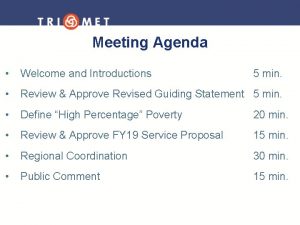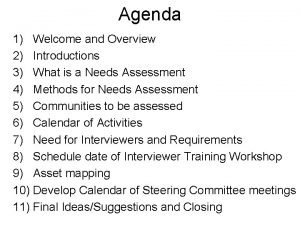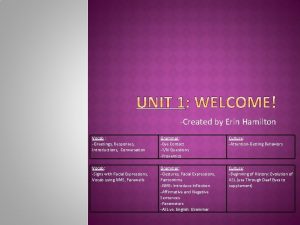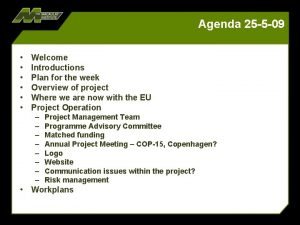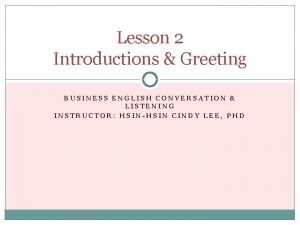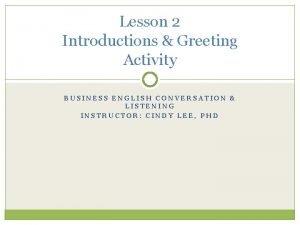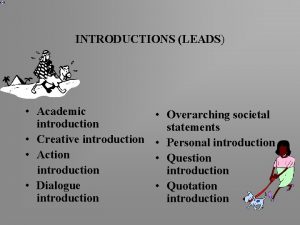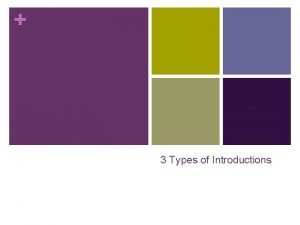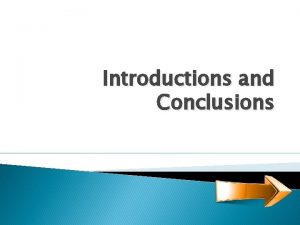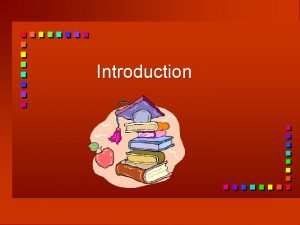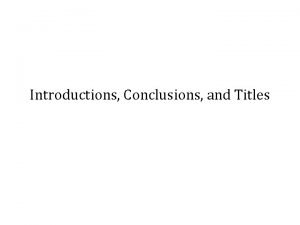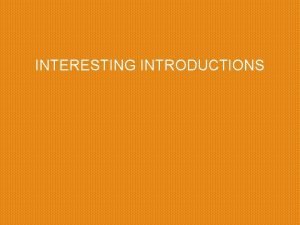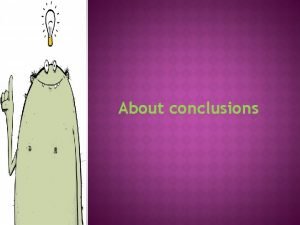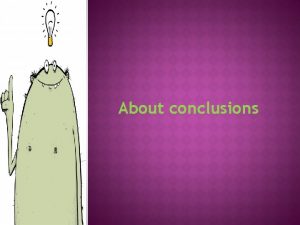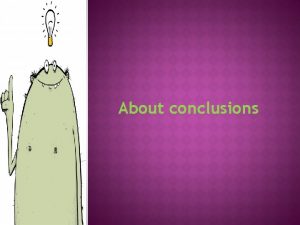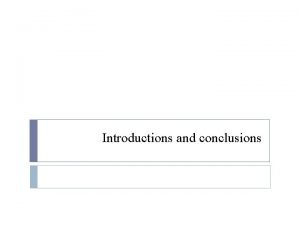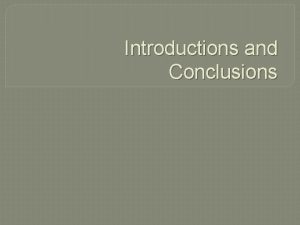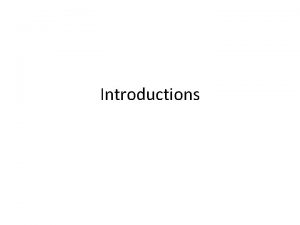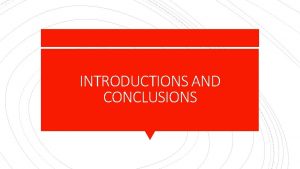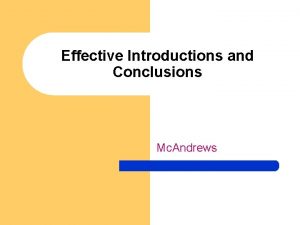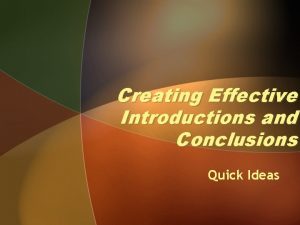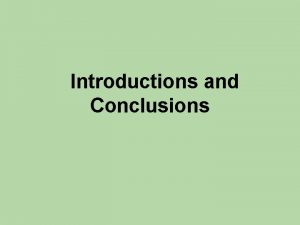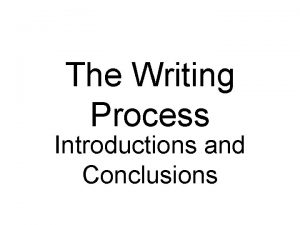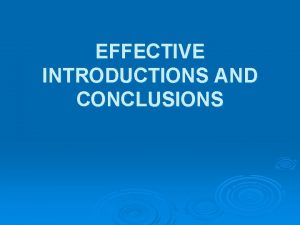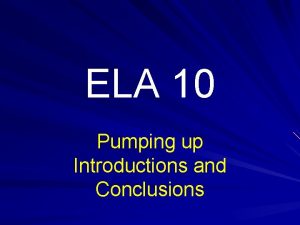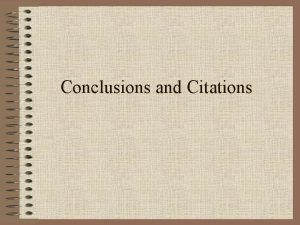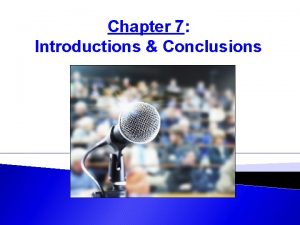Chapter 10 Introductions and Conclusions Introductions and Conclusions





























- Slides: 29

Chapter 10 Introductions and Conclusions

Introductions and Conclusions: Introduction • Your introduction and conclusion can make or break your presentation. • A strong introduction establishes rapport with listeners by: – Capturing their interest – Orienting them to your speech – Establishing your credibility as a speaker • A strong conclusion leaves an impression of you and your speech.

Introducing Your Speech: An Overview • A good introduction should: – Gain your audience’s attention – Signal your thesis – Show the importance of your topic – Establish your credibility – Preview your main points

Introducing Your Speech: Gain Your Audience’s Attention • Use an attention-getter: material that will capture your audience’s attention and interest at the start of the speech.

Gain Your Audience’s Attention: Tell a Story or Anecdote • Stories personalize a speech and entertain listeners. – Use a story that is relevant to your main message. – Make sure the story comes across as believable.

Gain Your Audience’s Attention: Offer a Striking or Provocative Statement • Surprise listeners by presenting a fact or startling idea that is: – New – Ironic – Counterintuitive • Use vivid language to grab the audience’s attention.

Gain Your Audience’s Attention: Build Suspense • Build suspense by providing an ambiguous or unfinished example to increase your audience’s curiosity.

Gain Your Audience’s Attention: Let Listeners Know You’re One of Them • Highlighting similarities helps: – Listeners trust you – Bridge the audiencespeaker gap

Gain Your Audience’s Attention: Use Humor • Use humor to put the audience at ease by telling a(n): – Joke – Amusing story – Funny anecdote • Make the humor relevant to your topic, audience, and the occasion. – Avoid offensive humor

Gain Your Audience’s Attention: Use Humor • Note that humor is a high risk/high reward approach.

Tips for Using Humor • Tip: A joke that makes its point effectively can increase your confidence and audience appeal, whereas a joke that falls flat or is “off color” can damage the introduction. • Tip: A humorous story from your own experiences often works more effectively than a joke.

Gain Your Audience’s Attention: Ask a Rhetorical Question • Ask a rhetorical question that has an obvious answer and does not require a response. • When using a rhetorical question: – Ensure that the question gets listeners thinking. – Avoid overly general questions that do not address audience’s real concerns and issues.


Gain Your Audience’s Attention: Provide a Quotation • Quote someone with high credibility whom your audience likes and respects. • Consider using a thought-provoking or counterintuitive quotation.

Introducing Your Speech: Signal Your Thesis • The thesis statement should reveal the speech’s “bottom line. ” • Make it clear that your attention-getter is over and you are about to reveal the main points of your real topic. • The thesis should clearly convey your topic and your purpose in delivering the presentation.

Introducing Your Speech: Signal Your Thesis

Introducing Your Speech: Show Your Audience “What’s in It for Them” • Motivate audience members to believe that you have their best interests in mind.

Introducing Your Speech: Establish Your Credibility • Demonstrate your knowledge and competence. • Briefly and modestly emphasize your recent, most relevant credentials.

Introducing Your Speech: Preview Your Main Points • Signal what main ideas the audience can expect, and in what order, with a preview. • Use signposts to help listeners understand the structure of your speech: – First – Next – Finally

Preview Your Main Points

Tips for Introducing Your Speech • Tip: Be sure any attention-getting device you use is linked to your topic. • Tip: The introduction is your first chance to help the audience pay attention to and understand your speech; make it easy for them.

Concluding Your Speech: An Overview • Conclusions should take one minute or less. • Sum up the speech body’s message and leave a memorable impression. • Conclusion format: – Transition to your conclusion. – Summarize your main points. – Finish with a memorable clincher.

Concluding Your Speech: Transition to Your Conclusion • Use transitional language that signals you are wrapping things up. • For example: – “Today, we have seen how important it is for every member of this class to participate in our annual campus food drive. ” – We have seen indicates you are finished with the main part of the speech and ready to move on to the next.

Concluding Your Speech: Summarize Your Main Points • A conclusion begins with a summary that reminds the audience of your thesis and reviews all the main ideas. • Summarize your main ideas in a compound sentence covering each main point or restate each point in a complete sentence.

Concluding Your Speech: Summarize Your Main Points

Concluding Your Speech: Finish with a Memorable Clincher • A clincher should be about 30 seconds long and leave an imprint on audience members’ minds. • Tie your clincher to the introduction. • End with a striking sentence or phrase that sums up your speech.

Concluding Your Speech: Finish with a Memorable Clincher • Conclude with an emotional message, particularly if you are delivering a persuasive or commemorative speech. • End with a story or anecdote that illustrates your message.


Tips for Concluding Your Speech • Tip: If you say, “and finally…” you better be wrapping up. Your audience will be irritated if you indicate you are almost done and keep on talking. • Tip: Your conclusion as well as your introduction should be written and prepared after you write the body of your speech.
 Agenda welcome and introductions
Agenda welcome and introductions Agenda welcome and introductions
Agenda welcome and introductions German greetings and introductions
German greetings and introductions Agenda welcome and introductions
Agenda welcome and introductions Agenda welcome and introductions
Agenda welcome and introductions Agenda welcome and introductions
Agenda welcome and introductions Agenda welcome and introductions
Agenda welcome and introductions Greetings and introductions lesson plan
Greetings and introductions lesson plan Asl greetings and introductions
Asl greetings and introductions Meeting agenda welcome and introductions
Meeting agenda welcome and introductions Agenda welcome and introductions
Agenda welcome and introductions Agenda welcome and introductions
Agenda welcome and introductions Agenda for parent orientation
Agenda for parent orientation Agenda welcome and introductions
Agenda welcome and introductions Agenda welcome and introductions
Agenda welcome and introductions Grabber for an essay
Grabber for an essay Greeting conversation
Greeting conversation Persuasive text scotland
Persuasive text scotland Survey introductions
Survey introductions Catchy introductions
Catchy introductions English business conversation
English business conversation Creative introductions
Creative introductions Types of introductions
Types of introductions Introductions clip art
Introductions clip art Introductions by marsha
Introductions by marsha British council introductions
British council introductions Pip conclusion example
Pip conclusion example Benjamin franklin quote and intro paragraph
Benjamin franklin quote and intro paragraph Interesting introductions
Interesting introductions Drawing conclusions and making inferences powerpoint
Drawing conclusions and making inferences powerpoint
